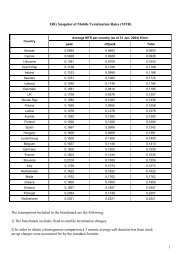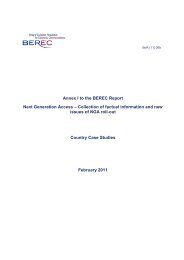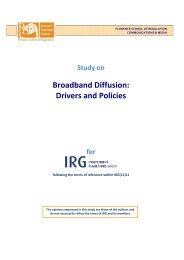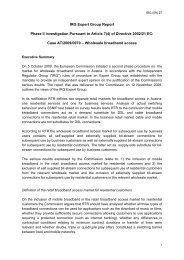You also want an ePaper? Increase the reach of your titles
YUMPU automatically turns print PDFs into web optimized ePapers that Google loves.
<strong>IRG</strong>-WG RA (<str<strong>on</strong>g>07</str<strong>on</strong>g>) <strong>WACC</strong> Master Doc<br />
Therefore the basic assumpti<strong>on</strong> of this methodology is that the pure play comparator’s cost<br />
of capital (or the benchmark of several pure play comparators' cost of capital if more than<br />
<strong>on</strong>e sufficient comparable pure play comparator is available) is equal to the unobservable<br />
cost of capital of the activity c<strong>on</strong>sidered.<br />
The validity of the pure play approach may be threatened by differences between the pure<br />
play comparator and the analysed activity regarding: i) systematic risk as the matching<br />
process is not simple, hence, in some cases, it would be naive to suppose that the cost of<br />
capital of the pure-play would corresp<strong>on</strong>d precisely to that of the analysed divisi<strong>on</strong>; ii) capital<br />
structure, as the “similar” company may have different amounts of debt, thus equity risk is<br />
different. In order to remove the impact of financial leverage the equity beta is usually unlevered<br />
through the calculati<strong>on</strong> of the un-levered or asset beta.<br />
Fuller & Kerr (1981) 19 provided empirical validati<strong>on</strong> for using the pure play approach<br />
examining a sample of multi-divisi<strong>on</strong> firms and pure-plays comparators associated with each<br />
divisi<strong>on</strong>. Potential pure plays were selected after screening a large number of firms,<br />
analysing their characteristics and ensuring the best possible match-ups with the relevant<br />
divisi<strong>on</strong>. They showed that an appropriately weighted average of the betas of the pure-play<br />
firms closely approximates the beta of the multi-divisi<strong>on</strong> firm. They c<strong>on</strong>cluded that the pureplay<br />
technique is a valid procedure for estimating the beta of a divisi<strong>on</strong>.<br />
As for vertical integrated and multi-products incumbents in the electr<strong>on</strong>ic communicati<strong>on</strong><br />
markets, if it is NRA’s opini<strong>on</strong> that the level of risk underpinning the services offered over the<br />
incumbents’ access network is lower than that faced by the incumbent as a whole, it will be,<br />
therefore, necessary to identify a proper pure play competitor whose beta can be used as a<br />
proxy for the incumbent access activity. However in practice is not so easy to identify proper<br />
pure play comparators of the incumbent access activity, as they should be<br />
telecommunicati<strong>on</strong>s operators involved just in the access activities. A possible soluti<strong>on</strong> could<br />
be either benchmarking the equity’s beta of the country’s largest not diversified utility<br />
companies or the equity betas of telecom companies involved mainly, if not solely, in access<br />
activities.<br />
Benchmarking against the betas of other utilities: Some characteristic of telecommunicati<strong>on</strong>s<br />
incumbents are similar to those of other utility companies such as gas, electricity or water<br />
companies. In fact, demand for products sold by these companies tends to be not str<strong>on</strong>gly<br />
correlated with aggregate demand, which implies a low level of beta. NRAs intending to<br />
calculate a disaggregated beta should therefore evaluate whether the value of other<br />
regulated domestic utilities ’s beta could be similar to that of the incumbent’s access activity,<br />
c<strong>on</strong>sidering also that the degree of systematic risk faced by a firm increases with the level of<br />
financial leverage. To make utility’s beta comparable with the incumbent’s beta it will be<br />
necessary to un-gear the equity’s beta.<br />
19<br />
Fuller R. and H. Kerr, 1981, “Estimating the divisi<strong>on</strong>al Cost of capital: An analysis of the Pure–Play<br />
Technique”, Journal of Finance, vol. XXXVI, n.5.<br />
28







